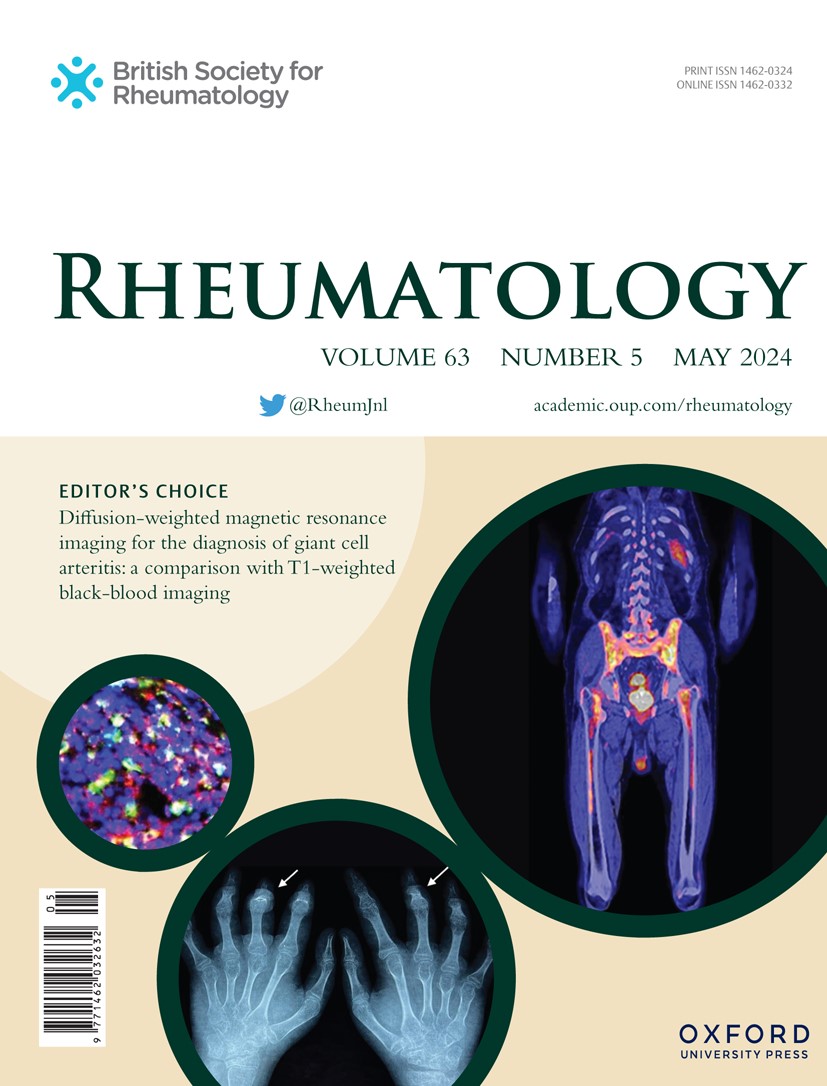Risk prediction model for relapse of anti-synthetase syndrome- associated interstitial lung disease in Japanese multicentre MYKO cohort study.
IF 4.4
2区 医学
Q1 RHEUMATOLOGY
引用次数: 0
Abstract
OBJECTIVES This study aimed to establish a risk prediction model for the relapse of anti-synthetase syndrome-associated interstitial lung disease (ASyS-ILD). METHODS Patients diagnosed with ASyS-ILD and treated with prednisolone and calcineurin inhibitors as remission induction therapy were enrolled in the Japanese multicentre MYKO cohort. We followed up on patients who experienced relapse of ASyS-ILD after remission induction therapy, and examined the risk factors for predicting relapse by comparing initial clinical and laboratory findings. RESULTS Of 487 patients diagnosed with idiopathic inflammatory myopathies between 1991 and 2024, 101 patients with ASyS-ILD were included. Tacrolimus was used by 81.2% of patients and 18.8% used ciclosporin as calcineurin inhibitors for a remission induction therapy. Thirty-nine patients (38.6%) relapsed ASyS-ILD during a median follow-up of 4.3 years, and 5-year relapse rate was 45.1%. Multivariate Cox regression analyses showed that the presence of acute/subacute ILD and a lower % forced vital capacity (FVC) on admission were independently identified as risk factors for relapse in patients with ASyS-ILD. Using the receiver operating curve analysis, %FVC ≤77% was determined as the cut-off levels for indicating a poor prognosis. The 5-year relapse rate was significantly higher in patients with acute/subacute ILD, % FVC ≤77% than in those without these parameters. A risk-prediction model (RPM) based on these parameters can stratify patients into low-, moderate-, and high-risk ILD relapse groups. CONCLUSION Our multicentre cohort study showed that the RPM model using the presence of acute/subacute ILD and %FVC values was a useful tool for stratifying risk of ASyS-ILD relapse.日本多中心MYKO队列研究中抗合成酶综合征相关间质性肺疾病复发的风险预测模型
目的建立抗合成酶综合征相关间质性肺疾病(ASyS-ILD)复发的风险预测模型。方法诊断为ASyS-ILD并接受强的松龙和钙调磷酸酶抑制剂作为缓解诱导治疗的患者被纳入日本多中心MYKO队列。我们随访了缓解诱导治疗后复发的ASyS-ILD患者,并通过比较初始临床和实验室结果来检查预测复发的危险因素。结果1991年至2024年间诊断为特发性炎性肌病的487例患者中包括101例ASyS-ILD患者。在缓解诱导治疗中,81.2%的患者使用他克莫司,18.8%的患者使用环孢素作为钙调磷酸酶抑制剂。中位随访4.3年,39例(38.6%)ASyS-ILD复发,5年复发率为45.1%。多因素Cox回归分析显示,急性/亚急性ILD的存在和入院时较低的用力肺活量(FVC)是独立确定的ASyS-ILD患者复发的危险因素。采用受试者工作曲线分析,确定%FVC≤77%为预后不良的临界值。急性/亚急性ILD患者的5年复发率(% FVC≤77%)明显高于无这些参数的患者。基于这些参数的风险预测模型(RPM)可以将患者分为低、中、高风险ILD复发组。结论:我们的多中心队列研究表明,使用急性/亚急性ILD和%FVC值的RPM模型是对ASyS-ILD复发风险进行分层的有用工具。
本文章由计算机程序翻译,如有差异,请以英文原文为准。
求助全文
约1分钟内获得全文
求助全文
来源期刊

Rheumatology
医学-风湿病学
CiteScore
9.40
自引率
7.30%
发文量
1091
审稿时长
2 months
期刊介绍:
Rheumatology strives to support research and discovery by publishing the highest quality original scientific papers with a focus on basic, clinical and translational research. The journal’s subject areas cover a wide range of paediatric and adult rheumatological conditions from an international perspective. It is an official journal of the British Society for Rheumatology, published by Oxford University Press.
Rheumatology publishes original articles, reviews, editorials, guidelines, concise reports, meta-analyses, original case reports, clinical vignettes, letters and matters arising from published material. The journal takes pride in serving the global rheumatology community, with a focus on high societal impact in the form of podcasts, videos and extended social media presence, and utilizing metrics such as Altmetric. Keep up to date by following the journal on Twitter @RheumJnl.
 求助内容:
求助内容: 应助结果提醒方式:
应助结果提醒方式:


